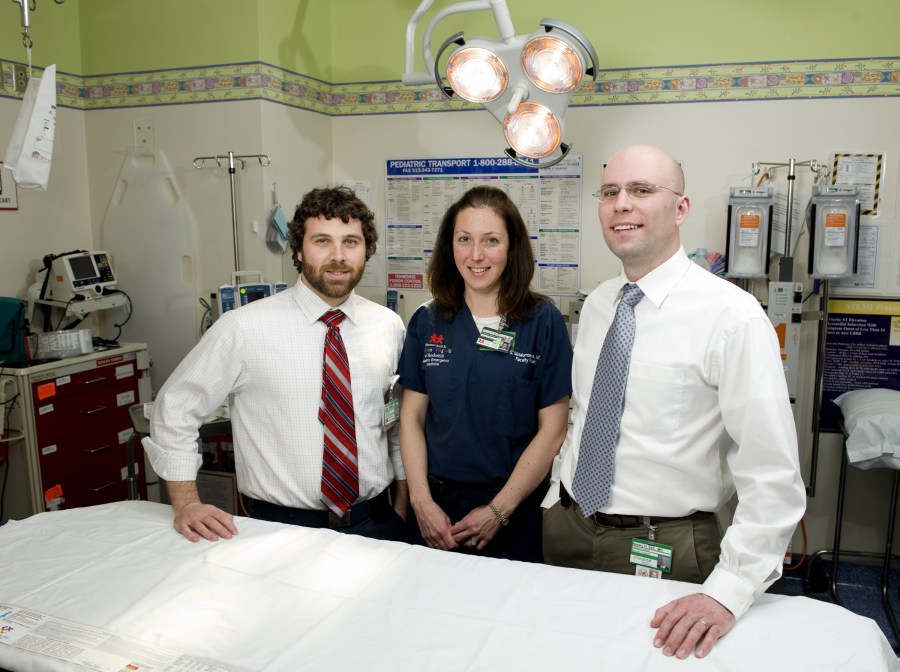
Derek Williams, M.D., left, Sheila McMorrow, M.D., and Wesley Self, M.D., in the Pediatric Emergency Department, where they are enrolling patients in a multi-center pneumonia study. (photo by Joe Howell)
Study explores pneumonia’s myriad causes
When 11-year-old Jordan Hatcher came to the Pediatric Emergency Department at the Monroe Carell Jr. Children's Hospital at Vanderbilt, she was experiencing shortness of breath, chest and back pain and a fever.
Doctors diagnosed pneumonia and inserted a chest tube to drain fluid that had accumulated in her chest.
The eighth-grader had never been significantly ill, so her family was anxious to learn what made her so sick. They were surprised when doctors told them it would be difficult to tell.
“They told me you can test for bacteria, and they do, but those tests don't usually tell you very much,” said her mother, Melissa Hatcher.

Kathryn Edwards, M.D.
The Hatchers agreed to include Jordan in a large new study under way at Vanderbilt and three other academic medical centers across the country seeking answers about the causes and effects of pneumonia.
The study is funded by the Centers for Disease Control and Prevention (CDC) and will enroll 6,400 patients nationwide, 2,600 at Vanderbilt, making it the largest community-acquired pneumonia study in more than a decade.
Kathryn Edwards, M.D., professor of Pediatrics and director of the Vanderbilt Vaccine Research Program (VVRP), is principal investigator for Vanderbilt and its participating neighboring hospitals.
“Pneumonia is still a leading cause of death and hospitalization in both children and adults, and there may be significant changes since the last large study in the 1990s,” Edwards said.
With the advent of vaccinations to protect against a variety of pneumonia-causing bacteria and viruses, it’s possible the pneumonia landscape has changed in the last decade. It simply is not known if most of today's pneumonia is caused by the usual suspects — like the flu — or something emerging. Causes can be viral, bacterial, or a mixture of the two.
“We can use modern molecular tests to look more closely at the microbes that cause pneumonia, and what co-infections might be involved in patients who are hospitalized,” Edwards said.
Polymerase chain reaction (PCR) testing will be used to identify which microbes, viral or bacterial, are present in pneumonia patients enrolled in the study.
In addition to PCR, several additional diagnostic methods, including antigen detection and serology, will be used. Derek Williams, M.D., a General Pediatrics fellow working with Edwards on the study, said patients like Jordan Hatcher illustrate why PCR testing is crucial.
“The standard tests today are bacterial culture, or growing the bacteria in a lab for identification. But like Jordan's case, a causative organism is recovered less than 10 percent of the time,” Williams said.
But PCR testing amplifies genetic signals bacteria and viruses leave behind, which should allow a definitive diagnosis of the cause of pneumonia in a much larger proportion of cases.
And Edwards points out that treatment of pneumonia is not specific. For the sickest patients, the current standard of care is wide-spectrum antibiotics. But that shotgun method is both expensive and could potentially lead to the development of resistant bacteria.
“This is very important for Emergency Medicine. It could tell us what presenting information predicts severe disease and which antimicrobials are appropriate in which patients,” said Wesley Self, M.D., assistant professor of Emergency Medicine and a quality scholar at the Veterans Administration Hospital.
Self is heading up patient enrollment in the adult ED while Sheila McMorrow, M.D., assistant professor of Emergency Medicine is helping in the Pediatric ED. McMorrow said this is one of the busiest respiratory illness seasons she has seen in the last few years.
“We put so many children on noninvasive ventilation and ventilator assistance in the Emergency Department, but may never learn the etiology of what made them so sick. It would be nice to know this information, not only in the treatment of the children who are sick now, but in the development of preventive vaccines or early interventions,” McMorrow said.
The goal is to enroll 1,000 adults and 300 children each year for the next two years at each site. Patients who are admitted with fever, respiratory symptoms and a chest X-ray indicating pneumonia, are eligible.
The lead institutions include VUMC and Northwestern University in Chicago for adult patients. Pediatric sites include the Monroe Carell Jr. Children's Hospital at Vanderbilt, St. Jude Children's Research Hospital and Le Bonheur Children's Medical Center in Memphis, University of Utah in Salt Lake City and Children's Memorial Hospital in Chicago.













